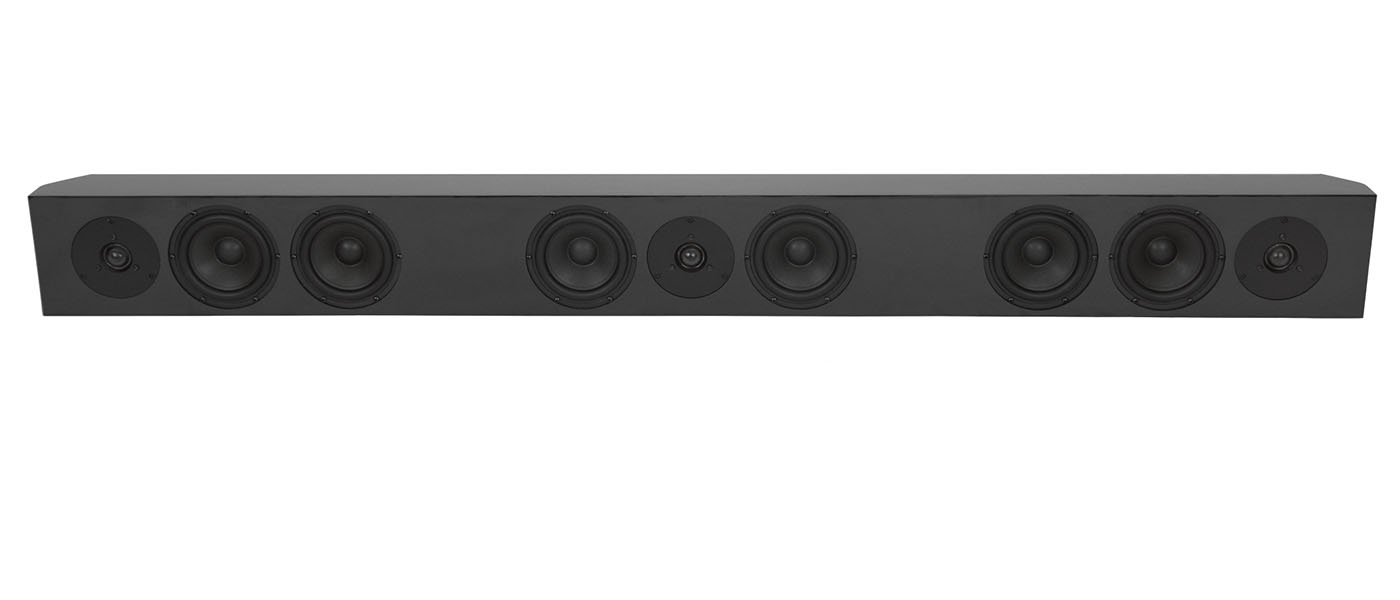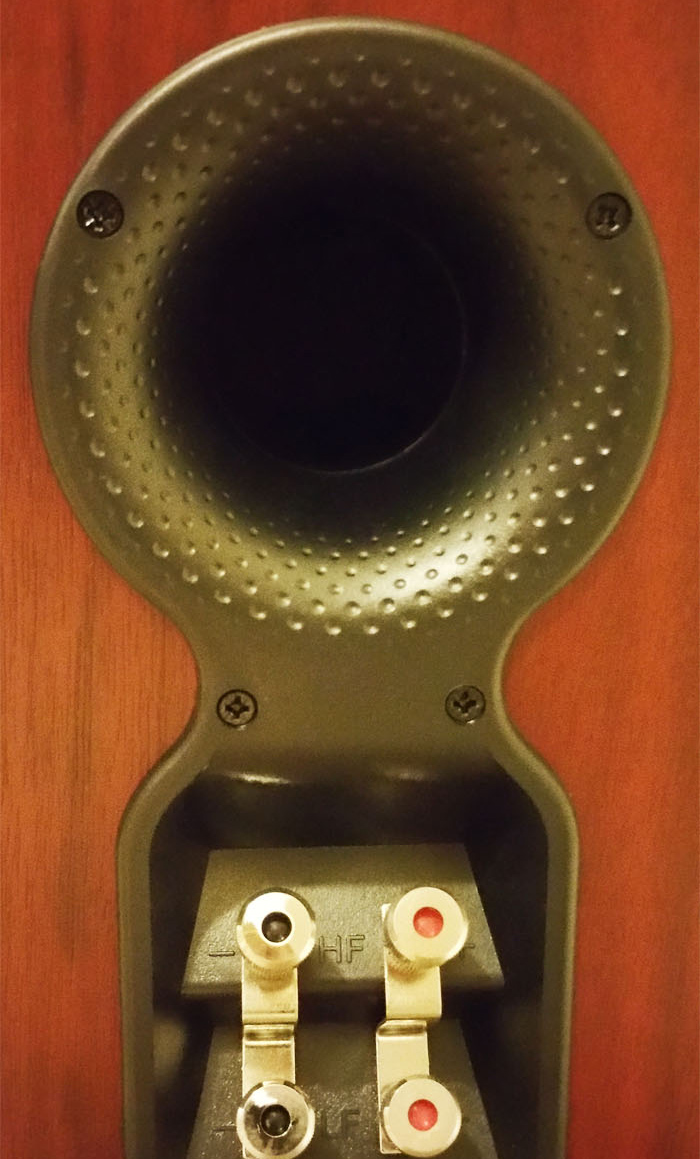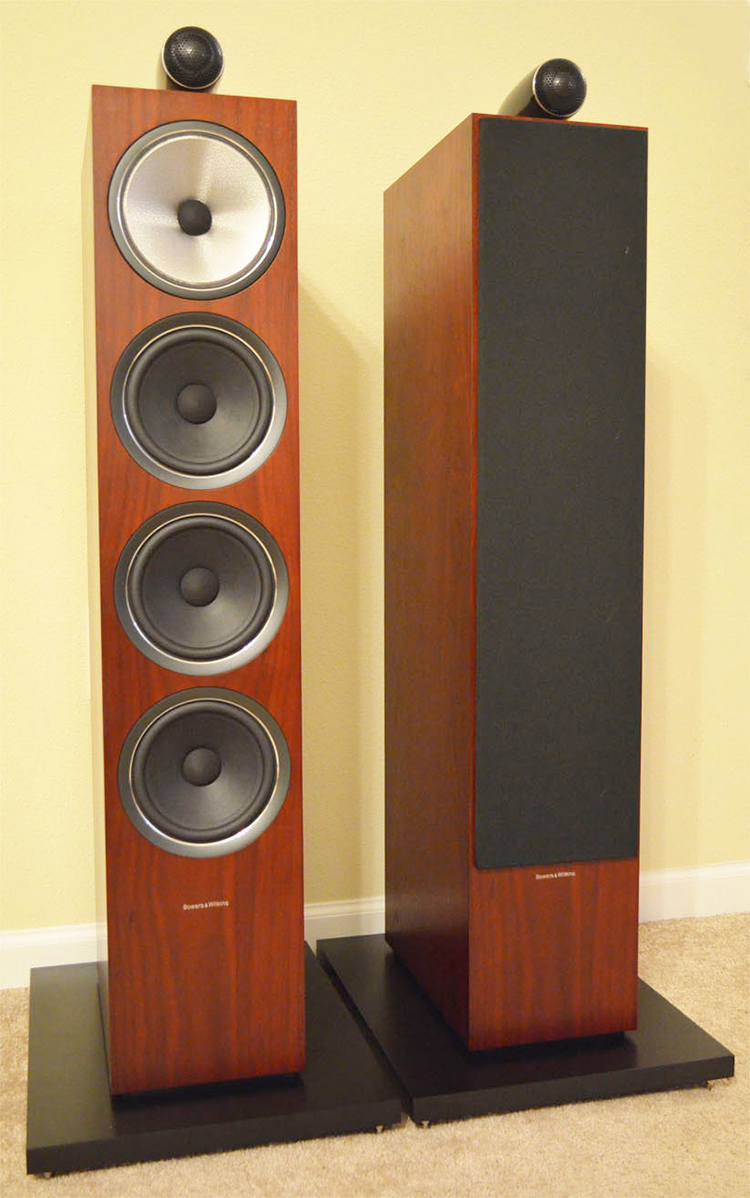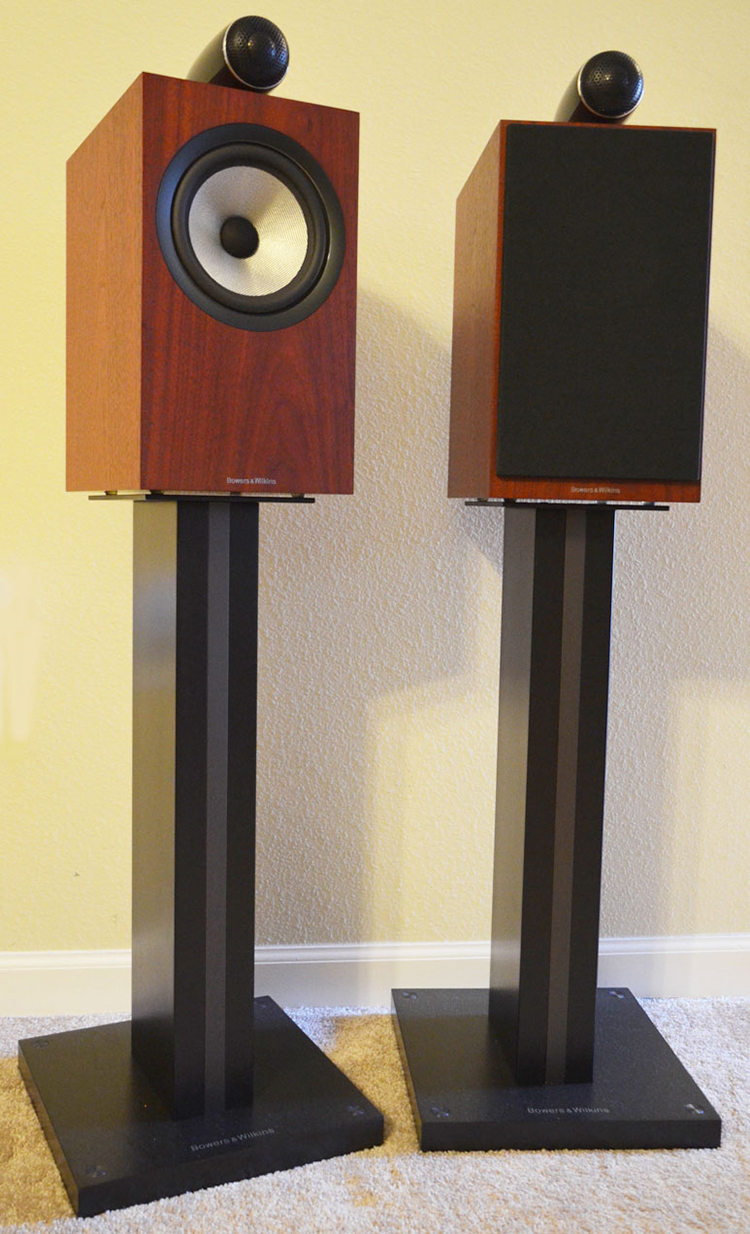The new 700 Series 2 speakers from Bowers & Wilkins (B&W) were debuted in September 2017 to supersede the long-running and successful CM series. The 700 Series is placed below the 800 Series Diamond range in the B&W home audio speakers lineup, but incorporates some of the 800 Series technologies, such as the Continuum Cone midrange, solid body tweeter housing, and Aerofoil profile bass drivers. Additionally, B&W also implements new technologies in the 700 Series 2 speakers most notably the Carbon Dome tweeter. For this review, B&W sent us 5.1 speaker configuration from the 700 Series, which include 702 S2 floorstanders, 705 S2 bookshelf speakers, HTM71 center channel, and DB4S subwoofer, all in beautiful rosenut finish. Bearing classic design geometry, these speakers look elegant with undeniably solid built quality. My listening evaluation reveals that the beauty of these speakers is not just skin deep. They are indeed a solid flag bearer for high-fidelity sound. The review below will describe in more details the features and performance of these speakers.
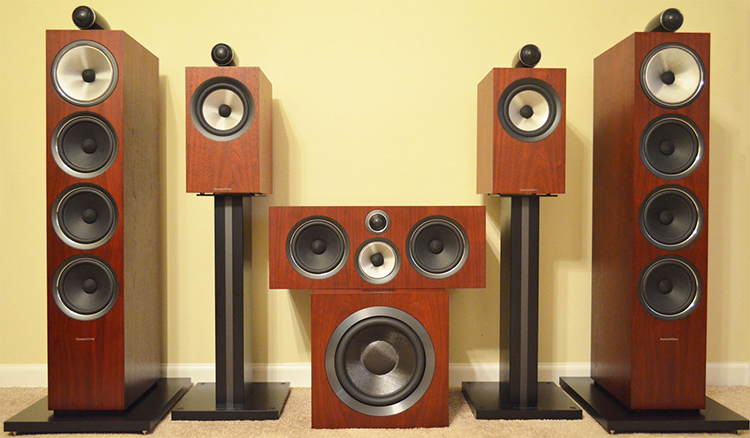
Bowers & Wilkins 2 Speaker System
- High-quality speaker components.
- Great construction quality and finish.
- Provision for bi-wire or bi-amp application.
- High-degree sonic transparency and details.
- Capable of focused and believable imaging in stereo applications.
- Excellent timbre match for smooth surround applications.
- Powerful feature-rich small subwoofer.
- Magnetically attached grilles.
Bowers & Wilkins (B&W) has had a long and solid reputation as a British manufacturer of high-fidelity speakers. Having been in the business since 1966, B&W has become one of the most recognizable brands in the audio world. A great deal of the success is contributed by the company’s dedication to apply new innovations and maintain high standard of quality of its products.
702 S2:
Description
2-way vented-box system
Drive units:
1x ø25mm (1 in) Decoupled Carbon Dome high-frequency
1x ø150mm (6 in) Continuum cone FST midrange
3x ø165mm (6.5 in) Aerofoil profile bass
Frequency response:
45Hz – 28kHz ±3dB
Sensitivity:
90dB spl (2.83Vrms, 1m)
Nominal impedance:
8Ω (minimum 3.1Ω)
Recommended amplifier power:
30W – 300W into 8Ω on unclipped program
Dimensions:
Height: 1087mm (42.8 in) including tweeter and plinth
Width: 366mm (14.4 in) including plinth
Depth: 364mm (14.3 in) including grille and terminals
Net weight:
29.5kg (65 lb)
Cabinet Finishes:
Rosenut, Gloss Black, or Satin White
MSRP:
$4500/pair
705 S2:
Description:
2-way vented-box system
Drive units:
1x ø25mm (1 in) Decoupled Carbon Dome high-frequency
1x ø165mm (6.5 in) Continuum cone bass / midrange
Frequency response:
50Hz – 28kHz ±3dB
Sensitivity:
88dB spl (2.83Vrms, 1m)
Nominal impedance:
8Ω (minimum 3.7Ω)
Recommended amplifier power:
30W – 120W into 8Ω on unclipped program
Dimensions:
Height: 407mm (16 in) including tweeter
Width: 200mm (7.8 in)
Depth: 301mm (11.9 in) including grille and terminals
Net weight:
9.3kg (20.5 lb)
Cabinet Finishes:
Rosenut, Gloss Black, or Satin White
MSRP:
$2500/pair
HTM71 S2:
Description:
3-way vented-box system
Drive units:
1x ø25mm (1 in) Decoupled Carbon Dome high-frequency
1x ø100mm (4 in) Continuum cone FST midrange
2x ø165mm (6.5 in) Aerofoil profile bass
Frequency response:
50Hz – 28kHz ±3dB
Sensitivity:
89dB spl (2.83Vrms, 1m)
Nominal impedance:
8Ω (minimum 4.0Ω)
Recommended amplifier power:
30W – 100W into 8Ω on unclipped program
Dimensions:
Height: 225mm (8.6 in)
Width: 590mm (23.2 in)
Depth: 301mm (11.9 in) including grille and terminals
Net weight:
18.3kg (39.7 lb)
Cabinet Finishes:
Rosenut, Gloss Black, or Satin White
MSRP:
$1350 each
DB4S:
Technical features:
1000W Class D Hypex amplifier
Aerofoil bass cone
Digital preamplifier with Dynamic EQ
App-based set-up and BT-LE control
Description:
Active closed-box subwoofer system
Drive units:
1x ø250mm (10in) Aerofoil cone bass
Frequency response:
10Hz – 350Hz -3dB (centred on level at 100Hz)
Max Power Output:
1000W
Inputs:
2 x RCA
2 x XLR
Input Impedance:
RCA: 10 kOhm
XLR: 20 kOhm
Signal to Noise Ratio:
82 dB
Dimensions:
Height 377mm (14.8 in) including feet
Width 360mm (14.1 in)
Depth 368mm (14.5 in)
Net Weight:
26kg (57.3 lb)
Cabinet Finishes:
Rosenut, Gloss Black, or Satin White
MSRP:
$1600 each
FS-700 S2 speaker stands
Description:
Speaker stand for use with the 700 Series bookshelf models. Featuring integrated cable management and sand-fill mass loading option.
Dimensions:
Height: 24.2” x Width: 11.4” depth: 11.7”
Net Weight:
13.2 lbs
Finishes:
Black or Silver
Price:
$500/pair
Company:
SECRETS Tags:
700 Series 2 Speaker System, Bowers & Wilkins, Bowers & Wilkins 700 Series 2 Speaker System, Speaker System Reviews 2018
B&W implements a number of state-of-the-art speaker technologies and design features in its new 700 Series 2 speakers, which reflects the company’s innovative approach in improving its products. In the B&W lineup, the 700 Series 2 represents a more affordable alternative to the highly acclaimed 800 Series Diamond and replaces the popular CM series. However, some of the advanced features that were used in the 800 Series Diamond speakers find their way into the 700 Series 2 products, such as the tweeter-on-top design in solid-body housing, the Continuum midrange cones, the decoupled midrange design, and the Aerofoil Profile bass cones. Besides these ‘trickled-down’ features from the 800 Series Diamond products, the 700 Series 2 speakers also employ new technological features developed specifically for the series, such as Carbon Dome tweeter.
Secrets Sponsor
This review will cover 5.1 configuration of 700 Series 2 speakers consisting of a pair of 702 S2 floorstanding speakers, a pair of 705 S2 bookshelf speakers, a HTM71 S2 center-channel speaker, and a DB4S powered subwoofer. The total 5.1 system cost is just a tad below $10,000. Not cheap for sure, but not astronomically expensive either. In the current industry landscape, based on its price, this system should fall somewhere in between medium-high and extreme high-end category. The materials, components, quality of constructions, and finish of the speakers are of high-quality all around.
B&W adopted simple classic rectangular-box design for the enclosure of the 700 S2 series speakers, just like the superseded CM series. Augmented by excellent built quality and finish, the speakers’ classic design looks elegance and their sculpture-like appearance is qualified as room-décor enhancement. Simple knock test reveals that the cabinets of these speakers are very well braced and should be free from unwanted resonances. The review samples (5 speakers and 1 subwoofer) come in matching beautiful rosenut finish. Option for glossy black or satin white finishes are also available to better suit some room decors. I like that the speaker grilles attach magnetically, so there are no holes or grilles mounting features degrading the look of the speakers’ front baffles when the grilles are not in use.
The 700 Series 2 speakers (except of course the DB4S subwoofer) sport Carbon Dome tweeters and Continuum midrange cones. The Carbon Dome tweeter is newly developed for this series as an improvement to the aluminum double-dome tweeter used in the CM series. The Carbon Dome tweeter is intended to raise the breakup frequency for better imaging and detail. On the 702 S2 and 705 S2 speakers these tweeters are housed in a solid-body aluminum for better resonance resistance and attached on the top baffles. Although this is a function-driven placement, it actually accentuates the appearance of the speakers and creates a distinctive look. The yellow midrange Kevlar drivers in the CM series have also been replaced by the shiny silver Continuum Cone drivers, which are first introduced in the 800 Series Diamond speakers. The Continuum drivers are said to control the breakup frequency better than the Kevlar drivers for more open and neutral midrange. The bass drivers of the speakers in this series, including the one used in the DB4S subwoofer, are of Aerofoil Profile cone type, which has a variable thickness for improved stiffness and rigidity. All the passive speakers in the 700 Series 2 lineup utilize a ported design using Flowport venting system, which minimizes turbulence by using dimples on its surface (like a golf ball). Foam plugs are supplied for bass-response volume adjustment. It is interesting to note that all of the 700 Series speakers down to the smallest 707 S2 mini monitors are equipped with two pairs of high-quality terminals to accommodate bi-wiring or bi-amplification. The speakers are shipped with the two pairs of the terminals connected using a pair of metal jumpers for non bi-wire configuration.
The 702 S2 speakers are the flagship floorstanders in the 700 Series 2 lineup. They are rather slim in appearance and supported by rectangular plinths for better stability. Spikes and rubber feet are supplied to provide better overall speaker support. The room for the review is carpeted, and hence I installed the spike feet to the plinth. The 702 S2 utilizes a 3-way vented-box design with 5 drivers: a 1ꞌꞌ tweeter in a separate solid-body enclosure on top, a 6ꞌꞌ midrange driver, and three 6.5ꞌꞌ bass drivers.
The 705 S2 represents the top model bookshelf speaker in the series. It utilizes a 2-way vented-box design with a separate solid-body enclosed 1ꞌꞌ tweeter on top (like the 702 S2) and a 6.5ꞌꞌ midrange/bass driver. For this speaker, the Continuum cone serves as both the midrange and bass driver. During the review, the speakers were placed on the FS-700 S2 stands, which are the matching stands for the B&W 700 Series 2 bookshelf speakers. The FS-700 S2 stands are solid looking stands with metal columns that are sand fillable and accommodate cable management.
The HTM71 S2 is the larger of the two center-channel speakers in the 700 Series 2 lineup. It is a 3-way vented-box system consisting of four drivers: a 1ꞌꞌ tweeter and a 4ꞌꞌ midrange driver in the middle front baffle flanked by two 6.5ꞌꞌ bass drivers. The HTM71 S2 has two Flowports on the back. The HTM71 S2 is not equipped with inclination adjustment feet. In fact, it does not have provision for insert-able or screw-able feet either. Only self-adhesive rubber feet to be attached on the base of the speakers are provided. If inclination adjustment is needed, placing this speaker on a tilt-able base would be the way to go.

Unlike the other speakers in the 700 Series 2 lineup, the DB4S subwoofer uses no Flowport. It utilizes a closed-box design with a 10ꞌꞌ driver. This subwoofer may look rather petite in the today’s subwoofer world, but it houses a powerful 1000 W Class D amplifier. Its specifications indicate that the DB4S is a very capable subwoofer with impressive low-reaching frequency response (-3 dB at 10 Hz and -6 dB at 8.5 Hz), which can put many of the bigger subwoofers out there to shame. I did not have the tool to verify this specification, but I did measure its in-room response using a test DVD and sound-level meter, which confirmed that the subwoofer still produced significant output in the infrasonic range of 16 Hz. The upper range of the frequency response is also impressive with -3 dB point at 350 Hz, which is sufficiently high for integration with small mini monitors.
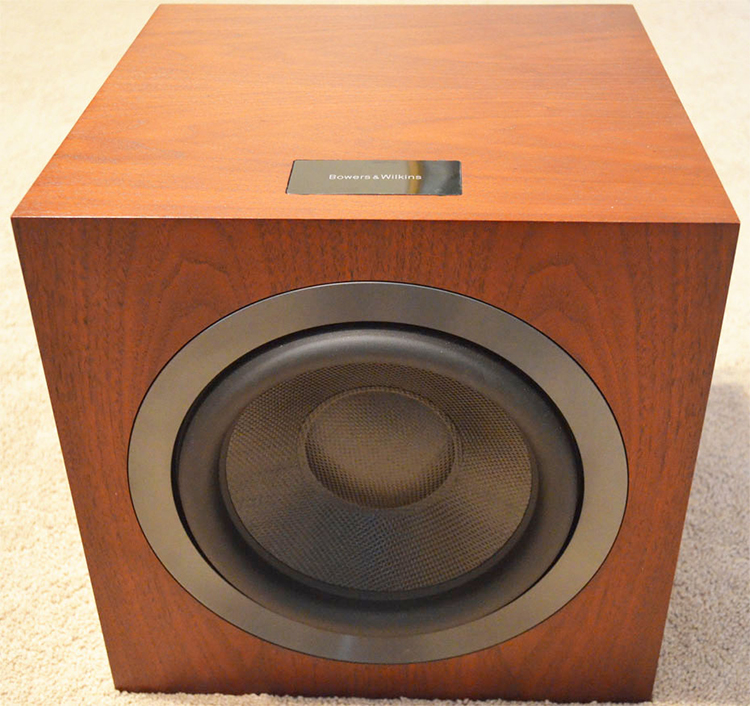
The rear panel of the DB4S subwoofer sports a pair of XLR and RCA input connectors. No other controls are available on the subwoofer, as it is meant to be set up and controlled using B&W’s own DB Subwoofers app, which is available for iOS and Android. The app uses a Bluetooth connection to communicate with the subwoofer. Once the app has been paired with the subwoofer, subsequent setup and control can be performed. The app is relatively user-friendly with interactive self-contained manual and has a good clean interface. The two types of input connectors on the back of the subwoofer can be used simultaneously to accommodate two different applications. For example, the XLR input connectors can be used for stereo application to provide bass augmentation to the front speakers while the RCA input connectors are being used for the Low Frequency Effects (LFE) channel in the surround setup. Integrating the DB4S subwoofer with the front main speakers for stereo full-range applications is relatively straightforward, as elaborated in the later part of this review. The DB4S also includes a room-correction feature, which can be handy for use in a system that does not have room-equalization capability. Many newer surround processors have such a feature, so this DB4S feature may seem redundant. But It is still a useful feature to have especially if the DB4S is used in a stereo setup (stereo preamplifier does not usually have room correction feature) or in a surround setup with no room-correction capability.

During the review, the speakers were mostly set up in a 5.1 surround configurations, where the 702 S2 served as the main left and right front speakers, the HTM71 S2 as the center-channel speaker, and the 705 S2 as the surround speakers, while the DB4S handled the low frequency effect (LFE) channel. Amplifiers from Bel Canto (REF500S: stereo, 250 W per channel into 8 ohms and EVO200.4: 4 channels, 120 W per channel into 8 ohms) and Proceed (AMP3: three channels, 150 W per channel into 8 ohms) were used in various combinations to drive the speakers. The front-end components used in the review included AURALiC ALTAIR music streamer, OPPO UDP-203 4K Ultra-HD capable Bluray player, and Bel Canto CD3t CD player with the DAC3.7 combination through the Krell KAV-280p preamplifier and Marantz AV8801 audio-video processor. A slight toe-in was applied to the main speakers (702 S2) to get the best image in the stereo playback. They were placed about 9 ft apart from each other and pulled into the room about 2 ft away from the back wall, which is as the closest boundary. The main listening position and location of the main speakers formed an equilateral triangle, following the suggestion in the manual of the speakers. The HTM71 S2 center channel occupied my regular center-channel location, which was on the stand right below the TV, about a foot below the listener’s sitting-position ear level. The surround speakers (705 S2) were put on the stands on the sides of the seating area, about 7 ft away from the main listening position. For the review, the DB4S was placed in between the two front speakers, closer to the left front speaker and at about a foot away from the back wall.
Secrets Sponsor
As part of the surround setup process, Audyssey MultEQ XT32 system, which came with the Marantz AV8801, was used to calibrate the level of the speakers and to apply dynamic room-correction equalization. Since the DB4S subwoofer also has its own equalization, the room correction process using the Audyssey system was done after the DB4S feature had been activated to avoid double bass-response compensation. In my case, the room-correction feature of the DB4S was useful to equalize the bass response especially during my 2.1 stereo evaluation. This room equalization feature can be accessed through the DB Subwoofers app and makes use of the microphone in the mobile device. The feature will only appear when the app is installed in a compatible mobile device. Currently the list of compatible devices includes iOS iPhone 5 onwards, Google Pixel, Samsung Galaxy S7, S7E, and S8. As you can see, the list is rather scarce for the compatible Android devices. I was informed that this is because the room-equalization feature relies on the device’s microphone sensitivity and calibration settings, which are more standard on iOS than on Android devices. This means that the codes need to be individually customized for Android devices. Even a listed compatible Android device may not work if the manufacturer alters the device specification. Such is my experience when I tried the room-equalization feature using Samsung Galaxy S7. It kept giving me a measurement-error message during the microphone-calibration stage of the process. The same happened with a different Samsung Galaxy S7 device, borrowed from my daughter. This failed attempts prompted me to contact the B&W support, which led me to the information above. Since no one in my household is an iPhone user, I had to borrow an unused iPhone 5 from a friend. The room-equalization feature of the subwoofer worked without a glitch on this iPhone. The whole process was quick and relatively easy. After the device’s microphone-calibration stage, the process required me to move to 8 different locations in the room and ran the test tone. Once this was done, the app displayed the problematic frequencies and their intensity in the room to be equalized. In my room, for example, I had main bass problem at 59 Hz and a secondary one at 19 Hz. The equalization was then activated based on this result. I could immediately tell that this feature worked very well, giving me smoother bass response all around with no obvious bass peaks and valleys due to room acoustic interactions. Obviously, this is a very desirable feature and I applaud B&W for implementing it on its subwoofer. I wish that in the future this feature can be implemented without relying too much on individual mobile-device settings.
I learned during this review that you could only give these B&W speakers justice after a good amount of break-in time. There was a noticeable change in the sonic character of the speakers before and after broken-in. This is especially obvious in the lower frequency response of the speakers. When I listened to the 702 S2 floorstanding speakers before broken in, I thought the speakers were very bass shy. After broken-in, the speakers produced noticeably improved bass response and hence, better overall sonic balance.
Although the speakers were set up in 5.1 configuration, I did spent significant hours listening in stereo mode using the front main speakers (702 S2). In stereo music application, the 702 S2 speakers impressed me with their sweet midrange and detailed yet smooth treble responses. I would think that the Continuum drivers and the solid-body housed Carbon dome tweeters implemented in the speakers had a significant contribution to this desirable sonic traits. But regardless, the midrange seems to always sound crystal clear and uncolored. Vocal presentations are realistic with no noticeable sonic artifacts that might cause unnatural nasality or sibilance.
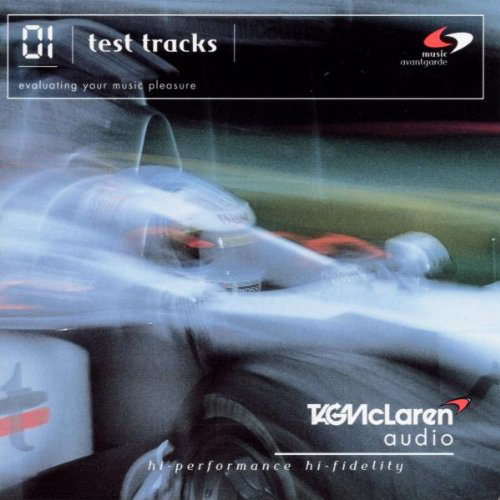
This was clearly exemplified by the in the acappella track This Love from the TAG McLaren 01 Test Tracks CD (1999). Through the 702 S2 speakers, the voice of Constanze Friend in this particular track sounded very natural with a high degree of palpability. The hyperbole “just like the singer was in the room in front of me” seemed to be a fitting description in this case.
Also from the same album, the unique voice of Bill Morrissey, which could be tricky to reproduce, in You’ll Never Get to Heaven sounded natural and full bodied. I have listened to this song in a wrong system, where his voice can become unnaturally too thin or too nasal. This particular song also showcased the treble richness of the 702 S2 speakers. The sound of the cymbals in the song was reproduced with realistic metallic characteristics and micro-dynamics details. Interestingly, the treble never became harsh even when the cymbals energy was on full display.
Moreover, the speakers’ ability to effortlessly generate focused sonic images in believable musical soundstage was outstanding. The singers and instruments’ locations were projected steadily in the soundstage created by the speakers. In general, the image presentation of the speakers was relatively neutral with sufficient soundstage depth. And in good recordings such as this one, the speakers had no problem in generating image wider from the boundary of the speakers.
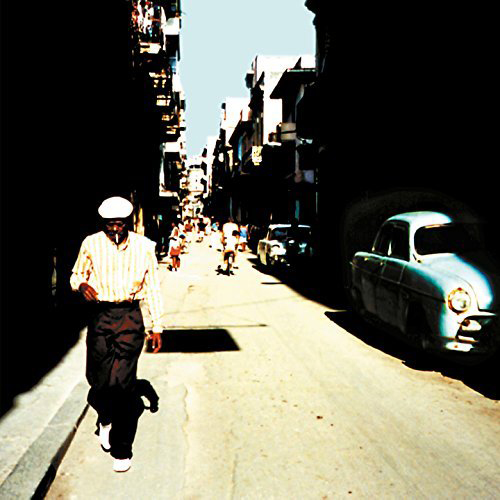
The track Chan Chan from the Latin Jazz album Buena Vista Social Club (1997) clearly highlighted the ability of the 702 S2 speakers to render believable listening atmosphere and soundstage. This track made me feel that I was listening to live music in a small jazz club. The sense of atmosphere envelopment primarily through the rendition of accurate sonic wall reflections and echo was convincingly delivered by the speakers.
The various-strength hits of the piano keys and the attacks of the drum were all rendered beautifully, fleshing out fully the rhythm and texture of the music. Separation among the musical instruments was conveyed vividly through the 702 S2 speakers.
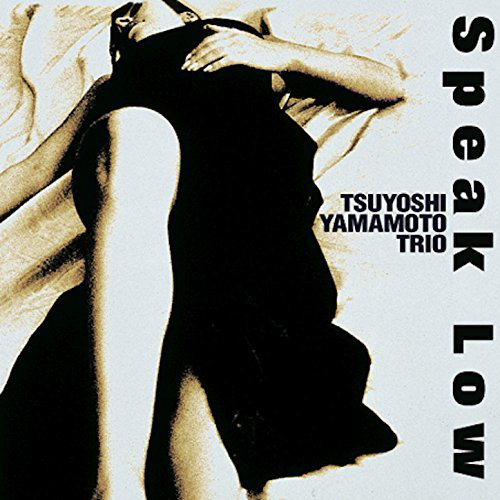
The 702 S2 speakers were also seemingly accurate in rendering attacks and transients. This was especially noticeable in music with rich energy texture such as exemplified by the excellent jazz album Speak Low (1999) by Tsuyoshi Yamamoto Trio. In the track Yesterdays from this album, the plucking of the double bass carried a sense of rawness that brought the music close to reality.
The bass response of the 702 S2 speakers was overall respectable. The speakers are capable of producing tight and articulative bass down to the mid-bass frequency range when called for. I also observed that these speakers needed a good amount of power to unleash their bass potential. I seemed to get better bass responses when driving them with a more powerful amplifier.
These are not full-range speakers, however, and with the specified -3 dB point at 45 Hz, when listening to music with low-bass content, I felt the incompleteness in the music. Bi-amping the speakers might increase the level of the bass, but not the bass extension. The solution that I did try was augmenting the low-bass response of the speakers using the DB4S subwoofer in a 2.1 configuration. There is a feature in the DB subwoofer app that makes integrating the DB4s with the 702 S2 speakers (or any other B&W speakers for that matter) a walk in the park. Basically all that I had to do was to feed the parallel outputs of my preamp to the DB4S, select Stereo connection mode (instead of LFE) from the DB Subwoofers app, and then select the model of the speakers (from the long list of the B&W speaker models) that the subwoofer will be used with. This would automatically configure the DB4S with the proper low-pass filter frequency cutoff, roll-off slope, and phase for the application. All I had left to do was to make a level adjustment to get the proper blend of the low-bass response with the rest of the frequency range. With non B&W speakers, a little bit more work would be needed to integrate the DB4S with the main speakers. You will need to select manually through the app the low-pass frequency, roll-off slope, and phase information for proper configuration of the subwoofer. I used, of course, the easy integration feature for the B&W family of speakers, which seemed to be dead on, yielding satisfying full-range sound from the integration of the DB4S with the 702 S2 speakers. The DB4S might be small, but it was capable of filling in the bottom end of the audible frequency spectrum with sufficient impact to deliver believable bass energy in the music.
On some occasions, I did pull in the 705 S2 to the front for comparison with the 702 S2 in stereo application. Except for the bass extension, which obviously the 702 S2 possesses the upper hand, the sonic performance of the two speakers was very close to each other. Their performance became even closer when they were augmented by the DB4S subwoofer to fill in the bottom frequency range. More careful listening, however, revealed that there was a subtle difference in their sonic characters. I felt that the midrange presentation of the 705 S2 was slightly less vivid compared to that of the 702 S2, which somehow resulted in a touch smoother midrange. I wouldn’t say this was better, but I wouldn’t be surprised either if some listeners preferred the smoother midrange presentation of the 705 S2 than the more vivid one of the 702 S2. Again, this difference was subtle and only noticeable after I listened to these speakers back and forth. Otherwise, the two speakers yielded almost indifferentiable sonic results when used with the DB4S subwoofer. Hence, most of my comments on the stereo performance of the 702 S2 speakers above should be applicable to the 705 S2 as well.
These B&W 700 Series 2 speakers were also a strong performer in surround applications. Whether in surround music or home-theater applications, these speaker system delivered refined sound with excellent uniform-sense of envelopment which was contributed by the accurate timbre match of the speakers. This was especially noticeable on movies with soundtrack containing a lot of background music, such as Jason Bourne (2016). The background music in this movie was crucial to complement the pace of the ongoing actions.
Through this B&W speaker system, the background music was delivered in good rhythm without drawing attention to itself or getting in the way of the actions from the scenes, excellently conveyed the up and down moods of the ongoing scenes in the movie.
I should give the HTM71 S2 a proper shout out here. For a center channel, the HTM71 S2 falls in the high price-bracket category, but its performance really backs its price of admission. During evaluation, it was clear that the HTM71 S2 ability to handle soundtrack dynamics was nothing short of excellent. It could play loud without strain, but even at relatively low volume, it was able to maintain very good sonic details and clarity. Dialogues sounded natural through it and in surround music applications, it blended seamlessly with the other 700 Series 2 members. I did not find any issue with the vertical and horizontal sound dispersion of the speaker. Even though the speaker was about 1 ft below my ear level and no inclination adjustment, I did not find noticeable sonic degradation from my main listening position. I also did not notice significant sonic differences when I sat about 1.5 m off center from my main listening position (to either side), which confirmed me that this was a well-designed center channel speaker, which should be able to anchor the center soundstage very well.
One would think that with its smooth and refined sonic nature, the B&W 700 Series 2 system would be more at home with delicate and more flowing soundtracks. But my finding also suggests that this speaker system is excellent in handling dynamic soundtracks.
The high-energy action sequences in Guardians of the Galaxy Vol. 2 (2017) was handled with aplomb by this system. This movie especially highlighted the dual-role competence of the DB4S subwoofer. I praised it in music application earlier and I found that this subwoofer was also a very capable performer in home-theater. It was seemingly never out of gas in delivering the various low-frequency content in many parts of the movie. The DB4S had no problem in producing impactful bass or delivering delicate low-frequency sound when called for in my relatively large and open listening environment. It is truly a first-rate subwoofer that elevates the sonic performance of the whole system.
With elegant design and excellent sonic performance in stereo and surround applications, B&W has created a winner in the 700 SERIES 2 SPEAKER SYSTEM.
- Elegant classic look with excellent built quality and beautiful finish
- Magnetically attached grilles
- Sonically transparent and rich in details
- Excellent timbre matching among the speakers in the series
- Awesome stereo and surround performances
- Powerful feature-rich small subwoofer with wireless mobile-device controls
- Adjustable inclination feature for the HTM71 S2 center-channel speaker
- Less device-dependent room-correction feature for the DB4S subwoofer
The B&W 700 Series 2 is a winner in many respects. These are the type of speakers that instill significant pride of ownership with their classic but elegant appearance, solid construction quality, and beautiful finish. Moreover, B&W does not shy away from equipping these speakers with latest in-house technological advances with the sole purpose of achieving studio-quality sound at home. My experience with reviewing these speakers suggests that B&W has successfully achieved this goal. The 700 Series 2 speakers put out impressive sonic performance in both stereo and surround applications.
In stereo music applications, whether with the 702 S2 floorstanders or the 705 S2 bookshelf speakers, the musicality of these speakers cannot be denied, producing sweet and transparent midrange with smooth and detailed highs. The ability of these speakers to image and project a believable soundstage is outstanding. As the speakers have restricted bass extension I recommend subwoofer augmentation to achieve the ultimate full frequency-range listening experience. I used the DB4S subwoofer, which is equipped with a feature for an easy and seamless integration especially with the B&W family of speakers, to augment the low-frequency response of the speakers with a great result. Moreover, this relatively small subwoofer has the room-acoustic correction feature that will improve further the system’s bass response.
In surround applications, the 5.1-configured 700 Series 2 speakers demonstrated excellent timbre match for seamless speaker-to-speaker sound transition, creating a uniform sense of sound envelopment. Moreover, the system’s excellent sonic attributes in dynamics, smoothness, details, and impact bring first-rate surround experiences, which should satisfy even the most critical home-theater aficionados. If these speakers fall within your budget, I would strongly recommend putting them on your short list to audition. I will not be surprised if these speakers wow you with their all-around strong performance that is worthy of their price of admission.


